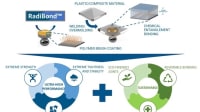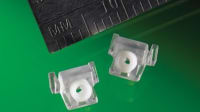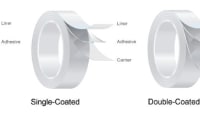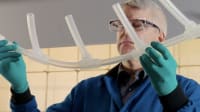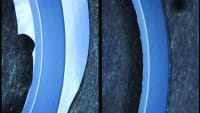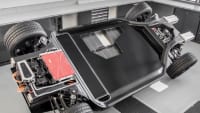Foam for NVH Solutions
New innovations for a wide variety of sound-deadening applications.

Sophisticated NVH tape
Avery Dennison FT 8392 is a high-performance, foam bonding tape ideal for automotive NVH applications. The 3.6 mil tape is a double-coated differential with an acrylic adhesive for the lamination side and a rubber adhesive for the substrate side featuring a PET film carrier. The acrylic adhesive laminates well to a wide variety of foams and offers dimensional stability and good die cutting characteristics. The rubber adhesive side bonds well to a variety of substrates including LSE plastics like polypropylene. A biocide additive inhibits mold growth as required in some specifications. In addition to bonding performance, this high-tech tape is capable of resisting the extreme high temperatures frequently encountered in vehicle interiors, the company claims. Avery Dennison has tested FT 8392 to many OEM specifications and provides over 100 certifications.
Tuned PUR foam for acoustics

From the headliner to the car floor, acoustically tuned polyurethane (PUR) foam solutions from Covestro can help enable a quieter ride – dropping decibels from automotive interiors, the company claims. When used in the IP, polyurethane can replace soft touch materials to provide a lighter assembly with the same or improved haptics. Load floors benefit from stiff and strong, yet light, polyurethane composite. When used in seating, polyurethane raw materials create lighter weight seat assemblies while delivering the same performance and properties of current foams. Additionally, raw materials for semi-rigid foam can replace shoddy pad or fiberglass in hood liners.
Covestro’s Baynat is a raw material for semi-rigid foam used in fiber reinforced composites for light-weight construction. Baynat-based foam is a very light-weight material available in densities between 15 and 40 kg/m3. The typical compression strength at 40% deflection in rise direction is in the range from 75-150 kPa (0,75 – 1,5 bar), the company claims.
Baynat-based foam is thermally insulating like expanded polystyrene but unlike other light-weight insulants it is both highly effective in noise absorption and resistant to rather high temperatures. One popular OEM application is the use as a core for the manufacture of sandwich headliners, for which Baynat is optimized for indoor emission and smell. The facings are composed of fiber-reinforced polyurea and decorative layers. This system not only allows rapid prototyping but can also serve as self-supporting acoustic panel.
Tired of noisy tires?

The continuous reduction of driving noises in automotive engineering has resulted in a greater focus of designers on the noise resonating from tire cavities. Tire manufacturers are increasingly adopting new acoustic foams that are bonded to the inside surface of the tread material in order to minimize the noise transfer. At the same time, there is a growing demand for in-tire bonded sensors to measure performance parameters such as tire pressure, tread depth or contact area.
Paving the road towards next-generation automotive tires with effective cavity noise reduction and increased sensor technology, Henkel has introduced Loctite SI 5930 FIT (for Fix in Tire), an RTV silicone rubber adhesive for in-tire bonding applications. SI 5930 FIT is a one-component room temperature vulcanizing material supplied as thixotropic black paste with a tack-free time of ≤15 minutes, depending on ambient humidity. The material offers excellent adhesion on all common tire rubbers used in the automotive industry, including mixtures for trucks and two-wheelers, the company said.
According to the company, the product provides excellent adhesion properties on all common tire rubbers and is compatible with different acoustic foams as well as tire release agents. As a MEKO-free and odorless solution it also meets strict HSE standards. In addition, Henkel supports tire manufacturers and suppliers with a comprehensive bonding test program and through collaborations with leaders in tire market consulting and dedicated wheel manufacturing equipment.
“A critical requirement of these functional tire designs is the long-term reliable bonding strength of the adhesive material even under severe road, driving and weather conditions,” said Wim Boone, senior sales engineer at Henkel. He said the Loctite SI 5930 FIT product has successfully demonstrated its adhesion performance from the tire production line to over one million kilometers (621,371 miles) of severe road testing.
Top Stories
INSIDERDefense
![]() F-35 Proves Nuke Drop Performance in Stockpile Flight Testing
F-35 Proves Nuke Drop Performance in Stockpile Flight Testing
INSIDERMaterials
![]() Using Ultrabright X-Rays to Test Materials for Ultrafast Aircraft
Using Ultrabright X-Rays to Test Materials for Ultrafast Aircraft
INSIDERManufacturing & Prototyping
![]() Stevens Researchers Test Morkovin's Hypothesis for Major Hypersonic Flight...
Stevens Researchers Test Morkovin's Hypothesis for Major Hypersonic Flight...
INSIDERManufacturing & Prototyping
![]() New 3D-Printable Nanocomposite Prevents Overheating in Military Electronics
New 3D-Printable Nanocomposite Prevents Overheating in Military Electronics
INSIDERRF & Microwave Electronics
![]() L3Harris Starts Low Rate Production Of New F-16 Viper Shield
L3Harris Starts Low Rate Production Of New F-16 Viper Shield
INSIDERRF & Microwave Electronics
Webcasts
Energy
![]() SAE Automotive Engineering Podcast: Additive Manufacturing
SAE Automotive Engineering Podcast: Additive Manufacturing
Manufacturing & Prototyping
![]() A New Approach to Manufacturing Machine Connectivity for the Air Force
A New Approach to Manufacturing Machine Connectivity for the Air Force
Automotive
![]() Optimizing Production Processes with the Virtual Twin
Optimizing Production Processes with the Virtual Twin
Power
![]() EV and Battery Thermal Management Strategies
EV and Battery Thermal Management Strategies
Energy
![]() How Packet Digital Is Scaling Domestic Drone Battery Manufacturing
How Packet Digital Is Scaling Domestic Drone Battery Manufacturing
Materials
![]() Advancements in Zinc Die Casting Technology & Alloys for Next-Generation...
Advancements in Zinc Die Casting Technology & Alloys for Next-Generation...








